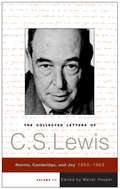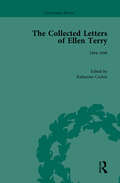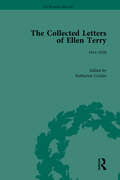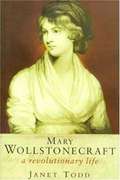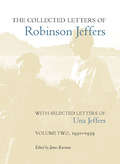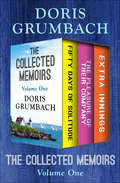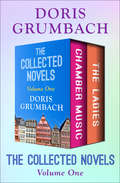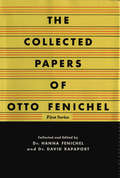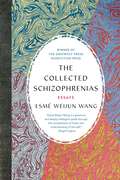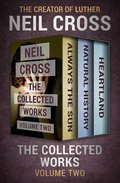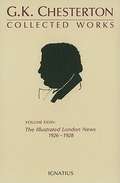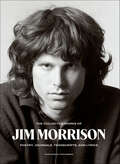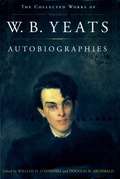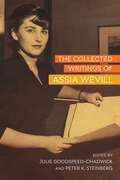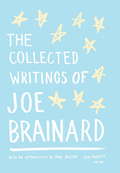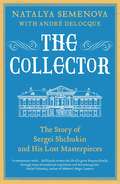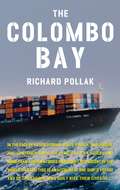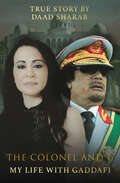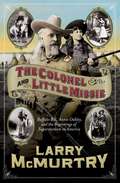- Table View
- List View
The Collected Letters of C.S. Lewis, Volume 3
by C. S. LewisThis collection, carefully chosen and arranged by Walter Hooper, is the most extensive ever published. Included here are the letters Lewis wrote to such luminaries as J.R.R. Tolkien, Owen Barfield, Arthur C. Clarke, Sheldon Vanauken, and Dom Bede Griffiths. To some particular friends, such as Dorothy L. Sayers, Lewis wrote fifty letters alone. The letters deal with all of Lewis's interests--theology, literary criticism, poetry, fantasy, children's stories--as well as his relationships with family members and friends. The third and final volume begins with Lewis, already a household name from his BBC radio broadcasts and popular spiritual books, on the cusp of publishing his most famous and enduring book, The Lion, the Witch and the Wardrobe, which would ensure his immortality in the literary world. It covers his relationship with and marriage to Joy Davidman Gresham, subject of the film Shadowlands, and includes letters right up to his death on November 22, 1963, the day John F. Kennedy was assassinated. This volume also includes both a special section of newly found letters from earlier time periods covered in volumes one and two and mini-biographies of Lewis's regular correspondents.
The Collected Letters of Ellen Terry, Volume 2 (The Pickering Masters)
by Katharine CockinEllen Terry's correspondence was both exuberant and extensive. Her remaining letters provide a fascinating insight into the dynamics of the Victorian theatre, and the difficulties of life for a woman maintaining a successful public persona whilst raising two illegitimate children.
The Collected Letters of Ellen Terry, Volume 3 (The Pickering Masters)
by Katharine CockinEllen Terry's correspondence was both exuberant and extensive. Her remaining letters provide a fascinating insight into the dynamics of the Victorian theatre, and the difficulties of life for a woman maintaining a successful public persona whilst raising two illegitimate children.
The Collected Letters of Ellen Terry, Volume 6 (The Pickering Masters)
by Katharine CockinEllen Terry's correspondence was both exuberant and extensive. Her remaining letters provide a fascinating insight into the dynamics of the Victorian theatre, and the difficulties of life for a woman maintaining a successful public persona whilst raising two illegitimate children.
The Collected Letters of Mary Wollstonecraft
by Mary Wollstonecraft Janet ToddYou will smile at an observation that has just occurred to me: -- I consider those minds as the most strong and original, whose imagination acts as the stimulus to their senses, Mary Wollstonecraft wrote in a letter contemplating the role of the imagination in human relationships. Enlightenment feminist and famed author of The Vindication of the Rights of Woman, Wollstonecraft was also one of the most distinctive letter writers of the eighteenth century. This volume contains all of her known correspondence. Wollstonecraft talked and thought on paper; her letters were a large part of the drama of her life. In them she grows from an awkward child of fourteen to the woman of thirty-eight facing death in childbirth. Where the letters of "bluestocking" writers such as Elizabeth Carter and Catherine Talbot have a public quality, Wollstonecraft's letters -- whether written in haste or carefully composed, opinionated, or vulnerable -- stand out among those of other contemporary writers for their candor and lack of sentimentality. They create a palpable world, a sense of inner vitality, revealing a woman of consistent character who nonetheless struggled to reconcile disparate aspects of her life: integrity and sexual longing; the needs and duties of a woman; motherhood and intellectual life; fame and domesticity; reason and passion. Written in cramped lodgings and swaying boats, in the wilds of Scandinavia and the chill of Paris in winter, these letters record not a finished, ordered life viewed retrospectively but the dynamic process of living. Collectively, they form a remarkable work of autobiography that reveals the many dimensions of Wollstonecraft's genius.
The Collected Letters of Robinson Jeffers
by Robinson Jeffers Una JeffersThe 1930s marked a turning point for the world. Scientific and technological revolutions, economic and social upheavals, and the outbreak of war changed the course of history. The 1930s also marked a turning point for Robinson Jeffers, both in his career as a poet and in his private life. The letters collected in this second volume of annotated correspondence document Jeffers' rising fame as a poet, his controversial response to the turmoil of his time, his struggles as a writer, the growth and maturation of his twin sons, and the network of friends and acquaintances that surrounded him. The letters also provide an intimate portrait of Jeffers' relationship to his wife Una--including a full account of the 1938 crisis at Mabel Dodge Luhan's home in Taos, New Mexico that nearly destroyed their marriage.
The Collected Memoirs Volume One: Fifty Days of Solitude, The Pleasure of Their Company, and Extra Innings
by Doris GrumbachThree memoirs about isolation, aging, and death from an author whose “private self is as intelligent and generous as her public persona” (Publishers Weekly).Fifty Days of Solitude: Faced with a rare opportunity to experiment with true solitude, Doris Grumbach decided to live in her coastal Maine home without speaking to anyone for fifty days. A New York Times Notable Book, the result is a “quiet, elegantly written” recollection about what it means to write, to be alone, and to come to terms with mortality (Publishers Weekly). The Pleasure of Their Company: As her eightieth birthday approaches, Doris Grumbach uses the event as an opportunity both to look backward and to grow. She weaves a delightful tapestry of “surprising and meaningful observations,” allowing readers a glimpse into her life and the characters that have peopled her nearly eight decades on Earth (Library Journal). Extra Innings: This New York Times Notable Book follows a year in Doris Grumbach’s life, beginning with the release of her memoir Coming into the End Zone, and revealing that she possesses as keen an eye in her seventies as she did when she wrote The Spoil of Flowers thirty years earlier. In this “clear, honest picture of her own old age,” Grumbach details each passing month with their trials and triumphs (Library Journal).
The Collected Novels Volume One: Chamber Music and The Ladies
by Doris GrumbachTwo compelling works of fiction from a feminist literary icon hailed as &“Virginia Woolf without the evasive prettifying&” (The New York Times).Chamber Music: Caroline Maclaren, the widow of a prominent composer, is finally going to tell her own life story. Taking pen to paper, she relives her sheltered youth, her chilly marriage to a brilliant man, and the melancholy solitude she experienced until she found loving companionship with her ill husband&’s caretaker, Anna. This masterful tale of passion late in life is widely considered Grumbach&’s finest work. The Ladies: In 1778, Eleanor Butler and Sarah Ponsonby left Ireland to live together in Wales as a married couple. Well-born and highly educated, the Ladies of Llangollen—as they came to be known—defied social convention, spending half a century in a devoted relationship. In this fictionalized account, Grumbach breathes vivid life into this fascinating story that is &“a true classic on that rarest of relationships, companions of the heart&” (San Francisco Examiner & Chronicle). A truly groundbreaking talent whose writing &“depicts lesbianism as a positive, life-giving force in women&’s lives,&” Doris Grumbach&’s words continue to move the hearts and minds of a new generation of readers (Ann Cothran).
The Collected Papers of Otto Fenichel (Vol #1)
by David Rapaport Otto Fenichel Hanna Fenichel<P> In the world of psychoanalysis, the late Otto Fenichel was pre-eminently distinguished for brilliant observation, tireless energy, and skill. Otto Fenichel's highly significant essays explore many subjects that were only touched on in his books. Many of these discussions, present-day classics in their fields, are comprehensive monographs in themselves. Often so much is brought to bear on the central topic from so many sources, and then related so clearly to the context, that these essays become works of reference for a much larger field. It is a contribution of the greatest value to preserve and make conveniently available so much that is intensely useful from the life work of this remarkable man.
The Collected Schizophrenias: Essays
by Esmé Weijun WangPowerful, affecting essays on mental illness, winner of the Graywolf Press Nonfiction Prize and a Whiting AwardAn intimate, moving book written with the immediacy and directness of one who still struggles with the effects of mental and chronic illness, The Collected Schizophrenias cuts right to the core. Schizophrenia is not a single unifying diagnosis, and Esmé Weijun Wang writes not just to her fellow members of the “collected schizophrenias” but to those who wish to understand it as well. Opening with the journey toward her diagnosis of schizoaffective disorder, Wang discusses the medical community’s own disagreement about labels and procedures for diagnosing those with mental illness, and then follows an arc that examines the manifestations of schizophrenia in her life. In essays that range from using fashion to present as high-functioning to the depths of a rare form of psychosis, and from the failures of the higher education system and the dangers of institutionalization to the complexity of compounding factors such as PTSD and Lyme disease, Wang’s analytical eye, honed as a former lab researcher at Stanford, allows her to balance research with personal narrative. An essay collection of undeniable power, The Collected Schizophrenias dispels misconceptions and provides insight into a condition long misunderstood.
The Collected Works Volume Two: Always the Sun, Natural History, and Heartland
by Neil CrossTwo taut psychological thrillers and a gripping memoir from the creator of the hit BBC crime series Luther and a “master of suspense” (Daily Mirror). The PEN/Ackerley Prize–shortlisted author and creator of Luther starring Idris Elba, British author Neil Cross is “an astonishing writer—tautly lyrical, and able at a stroke to fill you with cold, dark fear of the malign forces at large in the world” whether writing fiction or memoir (Time Out London). In this collection, Cross unflinchingly explores the dark side of parenting and family drama in ways equally startling and unforgettable. Always the SunLonglisted for the Man Booker Prize Looking for a fresh start after the death of his wife, Sam and his thirteen-year-old son, Jamie, return to Sam’s hometown. But at his new school, a group of kids led by a savage bully target Jamie, and the administration does nothing. When Jamie comes home bearing real, physical scars, Sam is left at a crossroads: How far will he go to protect his child? “Harrowing but gripping.” —Time Out London Natural History: In a last-ditch attempt to save their floundering marriage, Patrick and Jane founded an animal sanctuary called Monkeyland. But following the mysterious death of an ape, Patrick becomes obsessed, while Jane’s in Zaire shooting a nature show—and possibly cheating—and their son gets fired after an altercation. As a predatory cat stalks the periphery of the dilapidated zoo, Jane and Patrick’s search for wild beasts blinds them to the danger in their own backyard. “A masterpiece . . . seductively readable, no matter how much one dreads what may happen next.” —The Daily Telegraph HeartlandShortlisted for the PEN/Ackerley Prize In this “wonderful memoir,” Neil Cross tells the complicated story of his relationship with his stepfather. Derek Cross showers his young stepson with attention and love, teaches him about music and books, and is more reliable than Neil’s emotionally unstable mother. But as Neil grows older, he realizes the stepfather he loves is also a manipulator, adulterer, racist, and con man (The Guardian). “Moving and engrossing . . . Heartland is a tour de force.” —Daily Mail
The Collected Works Volume Two: Cuts, All Dressed Up and Nowhere to Go, and Doctor Criminale
by Malcolm BradburySharp-witted novels and social commentary by the beloved British critic, teacher, and author of the &“outstanding&” comic masterpiece, The History Man (The Guardian). &“A satirist of great assurance and accomplishment,&” Malcolm Bradbury remains one of the sharpest comic minds of the twentieth century (The Observer). Cuts and Doctor Criminale—like &“all Bradbury&’s novels, for all their surface wit and comedy, have serious moral and philosophical subtexts&” (The Guardian), as do his barbed and brilliant observations on 1950s culture shock in Great Britain in All Dressed Up and Nowhere to Go. Taken together, these three volumes illustrate the myriad ways &“Bradbury dazzles&” (Kirkus Reviews). Cuts: In Bradbury&’s &“outrageously funny&” satire set in Thatcher-era Great Britain, a media tycoon, looking to strike it rich with television gold, recruits an unassuming novelist and academic to script his small-screen epic, with disastrous—and hilarious—consequences (Publishers Weekly). &“It is funny, exact—and pretty bloody serious.&” —The Observer All Dressed Up and Nowhere to Go: In this nonfiction social commentary, Bradbury confronts a curious moment in British history. After teaching abroad for a year in the 1950s, he returned to find that his native country had become nearly as mystifying to him as the American Midwest. As Britain marched toward a new decade, much of the country was changing rapidly, its agrarian past paved over by suburban developer and its quiet traditionalism replaced by beehive hairdos and shiny, glass-walled office buildings. With wry wit, he reacts to this uncomfortable transition to mid-twentieth-century modernism. &“A master not only of language and comedy but of feeling too.&” —The Sunday Times Doctor Criminale: &“Playful, smart and entertaining,&” Bradbury&’s comic novel follows enterprising young reporter Francis Jay as he attempts to navigate the chaotic world of post–Cold War Europe in pursuit of the specter of literary legend Bazlo Criminale, a mysterious novelist and thinker known for his extreme elusiveness (The New York Times Book Review). &“Bradbury writes with splendid energy and a fertile mind.&” —Los Angeles Times Book Review
The Collected Works of G. K. Chesterton XXXIV The Illustrated London News 1926-1928
by G. K. Chesterton Lawrence J. ClipperThis 34th Volume is a collection of articles written by G.K. Chesterton in The Illustrated London News during 1926-1928.
The Collected Works of Jim Morrison: Poetry, Journals, Transcripts, and Lyrics
by Jim MorrisonNEW YORK TIMES BESTSELLERThe definitive anthology of Jim Morrison's writings with rare photographs and numerous handwritten excerpts of unpublished and published poetry and lyrics from his 28 privately held notebooks.You can also hear Jim Morrison’s final poetry recording, now available for the first time, on the CD or digital audio edition of this book, at the Village Recorder in West Los Angeles on his twenty-seventh birthday, December 8, 1970. The audio book also includes performances by Patti Smith, Oliver Ray, Liz Phair, Tom Robbins, and others reading Morrison’s work. Created in collaboration with Jim Morrison’s estate and inspired by a posthumously discovered list entitled “Plan for Book,” The Collected Works of Jim Morrison is an almost 600-page anthology of the writings of the late poet and iconic Doors’ front man. This landmark publication is the definitive opus of Morrison’s creative output—and the book he intended to publish. Throughout, a compelling mix of 160 visual components accompanies the text, which includes numerous excerpts from his 28 privately held notebooks—all written in his own hand and published here for the first time—as well as an array of personal images and commentary on the work by Morrison himself. This oversized, beautifully produced collectible volume contains a wealth of new material—poetry, writings, lyrics, and audio transcripts of Morrison reading his work. Not only the most comprehensive book of Morrison’s work ever published, it is immersive, giving readers insight to the creative process of and offering access to the musings and observations of an artist whom the poet Michael McClure called “one of the finest, clearest spirits of our times.” This remarkable collector’s item includes: Foreword by Tom Robbins; introduction and notes by editor Frank Lisciandro that provide insight to the work; prologue by Anne Morrison ChewningPublished and unpublished work and a vast selection of notebook writings The transcript, the only photographs in existence, and production notes of Morrison’s last poetry recording on his twenty-seventh birthday The Paris notebook, possibly Morrison’s final journal, reproduced at full reading sizeExcerpts from notebooks kept during his 1970 Miami trialThe shooting script and gorgeous color stills from the never-released film HWYComplete published and unpublished song lyrics accompanied by numerous drafts in Morrison’s handEpilogue: “As I Look Back”: a compelling autobiography in poem form Family photographs as well as images of Morrison during his years as a performer
The Collected Works of W. B. Yeats Volume III: Autobiographies
by William Butler Yeats Douglas Archibald William O'DonnellAutobiographies consists of six autobiographical works that William Butler Yeats published together in the mid-1930s to form a single, extraordinary memoir of the first fifty-eight years of his life, from his earliest memories of childhood to winning the Nobel Prize for Literature. This volume provides a vivid series of personal accounts of a wide range of figures, and it describes Yeats's work as poet and playwright, as a founder of Dublin's famed Abbey Theatre, his involvement with Irish nationalism, and his fascination with occultism and visions. This book is most compelling as Yeats's own account of the growth of his poetic imagination. Yeats thought that a poet leads a life of allegory, and that his works are comments upon it. Autobiographies enacts his ruling belief in the connections and coherence between the life that he led and the works that he wrote. It is a vision of personal history as art, and so it is the one truly essential companion to his poems and plays. Edited by William H. O'Donnell and Douglas N. Archibald, this volume is available for the first time with invaluable explanatory notes and includes previously unpublished passages from candidly explicit first drafts.
The Collected Works of W. B. Yeats Volume III: Autobiographies
by William H. O'Donnell William Butler Yeats Douglas N. ArchibaldThe Collected Works of W. B. Yeats, Volume III: Autobiographies is part of the fourteen-volume series overseen by eminent Yeats scholars Richard J. Finnerah and George Mills Harper. The series includes virtually all of the Nobel laureate's published work, with authoritative and explanatory notes. Autobiographies consists of six autobiographical works --Reveries Over Childhood and Youth, The Trembling of the Veil, Dramatis Personae, Estrangement, The Death of Synge, and The Bounty of Sweden-- that William Butler Yeats published together in the mid-1930s to form a single, extraordinary memoir of the first fifty-eight years of his life, from his earliest memories of childhood to winning the Nobel Prize for Literature. This volume provides a vivid series of personal accounts of a wide range of figures, and it describes Yeats's work as poet and playwright, as a founder of Dublin's famed Abbey Theatre, his involvement with Irish nationalism, and his fascination with occultism and visions. This book is most compelling as Yeats's own account of the growth of his poetic imagination. Yeats thought that a poet leads a life of allegory, and that his works are comments upon it. Autobiographies enacts his ruling belief in the connections and coherence between the life that he led and the works that he wrote. It is a vision of personal history as art, and so it is the one truly essential companion to his poems and plays. Edited by William H. O'Donnell and Douglas N. Archibald, this volume is available for the first time with invaluable explanatory notes and includes previously unpublished passages from candidly explicit first drafts.
The Collected Writings of Assia Wevill
by Julie Goodspeed-Chadwick and Peter K. SteinbergThe Collected Writings of Assia Wevill marks a significant development in literary recovery efforts related to Assia Wevill (1927–1969), who remains a critically important figure in the life and work of the Pulitzer Prize–winning poet Sylvia Plath and the British Poet Laureate Ted Hughes. Editors Julie Goodspeed-Chadwick and Peter K. Steinberg located over 150 texts authored by Assia Wevill and curated them into a collected scholarly edition of her letters, journals, poems, and other creative writings. These documents chronicle her personal and professional lives, her experiences as a single working mother in 1960s London, her domestic life with Hughes, and her celebrated translations of poetry by Yehuda Amichai. The Collected Writings of Assia Wevill offers an invaluable documentary resource for understanding a woman whose life continues to captivate readers and scholars.
The Collected Writings of Joe Brainard
by Paul Auster Ron PadgettAn artist associated with the New York School of poets, Joe Brainard (1942-1994) was a wonderful writer whose one-of-a-kind autobiographical work I Remember ("a completely original book" -Edmund White) has had a wide and growing influence. It is joined in this major new retrospective with many other pieces that for the first time present the full range of Brainard's writing in all its deadpan wit, madcap inventiveness, self-revealing frankness, and generosity of spirit. The Collected Writings of Joe Brainard gathers intimate journals, jottings, stories, one-liners, comic strips, mini-essays, and short plays, many of them available until now only as expensive rarities, if at all. "Brainard disarms us with the seemingly tossed- off, spontaneous nature of his writing and his stubborn refusal to accede to the pieties of self-importance," writes Paul Auster in the introduction to this collection. "These little works . . . are not really about anything so much as what it means to be young, that hopeful, anarchic time when all horizons are open to us and the future appears to be without limits." Assembled by the author's longtime friend and biographer Ron Padgett and including fourteen previously unpublished works, here is a fresh and affordable way to rediscover a unique American artist.
The Collector of Lives: Giorgio Vasari And The Invention Of Art
by Noah Charney Ingrid RowlandIn the tradition of The Swerve and How to Live, this vivid biography reveals how a Renaissance scholar reshaped the visual world. Giorgio Vasari (1511–1574) was a man of many talents—a sculptor, painter, architect, writer, and scholar—but he is best known for Lives of the Artists, the classic account that singlehandedly invented the genre of artistic biography and established the canon of Italian Renaissance art. Before Vasari’s extraordinary book, art was considered a technical skill rather than an intellectual pursuit, and artists were mere decorators and craftsmen. It was through Vasari’s visionary writings that artists like Raphael, Leonardo, and Michelangelo came to be regarded as great masters of life as well as art, their creative genius celebrated as a divine gift. Their enduring reputations testify to Vasari’s profound yet unspoken influence on western culture. An advisor to kings and pontiffs—and a confidant to Titian, Donatello, and more—Vasari enjoyed an exhilarating career amid the thrilling culture of Renaissance Italy. In The Collector of Lives, Ingrid Rowland and Noah Charney offer a lively and inviting introduction to this pivotal figure in art history, and immerse readers in the world of the Medici of Florence and the popes of Rome. A narrative of intrigue, scandal, and colorful artistic rivalry, this vivid biography shows the great works of western art taking shape under Vasari’s keen eye—and reveals how one Renaissance scholar completely redefined how we look at art.
The Collector of Worlds: A Novel of Sir Richard Francis Burton
by Iliya Troyanov William HobsonThis fictionalized account imagines the life of Sir Richard Francis Burton--a nineteenth-century British colonial officer with a rare ability to assimilate into indigenous cultures.
The Collector: The Story of Sergei Shchukin and His Lost Masterpieces
by Natalya Semenova André-Marc Delocque-FourcaudA fascinating life of Sergei Shchukin, the great collector who changed the face of Russia’s art world Sergei Shchukin was a highly successful textiles merchant in the latter half of the nineteenth century, but he also had a great eye for beauty. He was one of the first to appreciate the qualities of the Impressionists and Post-Impressionists and to acquire works by Cézanne, Matisse, and Picasso. A trailblazer in the Russian art world, Shchukin and his collection shocked, provoked, and inspired awe, ridicule, and derision among his contemporaries. This is the first English-language biography of Sergei Shchukin, written by art historian Natalya Semenova and adapted by Shchukin's grandson André Delocque. Featuring personal diary entries, correspondence, interviews, and archival research, it brings to light the life of a man who has hitherto remained in the shadows, and shows how despite his controversial reputation, he opened his collection to the public, inspiring a future generation of artists and changing the face of the Russian art world.
The Colombo Bay
by Richard PollakIn the face of killer storms, fires, piracy, and terrorism, container ships the length of city blocks and more than a dozen stories high carry 90 percent of the worlds trade. This is an account of one ship's voyage and of the sailors who daily risk their lives to deliver six million containers a year to United States ports alone. Inside these twenty-foot and forty-foot steel boxes are the thousands of imports -- from chinos and Game Boys to garlic and frozen shrimp -- without which North America's consumer society would collapse. To explore this little-known and dangerous universe of modern seafaring, Richard Pollak joined the Colombo Bay in Hong Kong and over the next five weeks sailed with her and her 3,500 containers across the South China Sea, the Indian Ocean, the Mediterranean, and the Atlantic. En route, this mammoth vessel called at Singapore and Colombo, passed through the Suez Canal (toll: $250,000), then put in at Malta and Halifax before tangling with Hurricane Karen on the two-day run to New York. Here is the story of the ship's unheralded twenty-four-man company; of the unflappable British captain, Peter Davies, a veteran of four decades at sea; of Federico Castrojas, who like the rest of the hard-working Filipino crew must daily confront the loneliness of being away from his family for nine months at a stretch; of Simon Westall, the twenty-one-year-old third mate, who reveals what it is like to be gay in the broad-shouldered world of the merchant service. It is a world where pirates in the Malacca Strait sneak up behind ships at night in fast power boats, then clamber aboard and either rob the unarmed sailors at gunpoint and escape into the dark or throw the crew into the sea and hijack the ship, plundering her cargo and sometimes repainting her and setting out to do business under another name and flag. It is a world where families desperate to get to the United States or Europe pay thousands of dollars to the Chinese Snakeheads and other criminal gangs, who secrete these wretched migrants in stifling containers; after a week or more at sea these stowaways arrive in the Promised Land either starving or dead. Pollak sailed on September 13, 2001, into a changed world, on one of 7,000 container ships whose millions of uninspected boxes suddenly had become potential Trojan horses in which terrorists could transport weapons of mass destruction into the heart of the United States. Throughout his riveting narrative, Pollak interweaves the insights of Herman Melville and Joseph Conrad, whose masterful portrayals of seafaring make the voyage of the Colombo Bay a dramatic reminder of what a hard and rarely reported life merchant seamen have always led out on the "unhooped oceans of this planet. "
The Colombo Bay
by Richard PollakIn the face of killer storms, fires, piracy, and terrorism, container ships the length of city blocks and more than a dozen stories high carry 90 percent of the worlds trade. This is an account of one ship's voyage and of the sailors who daily risk their lives to deliver six million containers a year to United States ports alone. Inside these twenty-foot and forty-foot steel boxes are the thousands of imports -- from chinos and Game Boys to garlic and frozen shrimp -- without which North America's consumer society would collapse.To explore this little-known and dangerous universe of modern seafaring, Richard Pollak joined the Colombo Bay in Hong Kong and over the next five weeks sailed with her and her 3,500 containers across the South China Sea, the Indian Ocean, the Mediterranean, and the Atlantic. En route, this mammoth vessel called at Singapore and Colombo, passed through the Suez Canal (toll: $250,000), then put in at Malta and Halifax before tangling with Hurricane Karen on the two-day run to New York. Here is the story of the ship's unheralded twenty-four-man company; of the unflappable British captain, Peter Davies, a veteran of four decades at sea; of Federico Castrojas, who like the rest of the hard-working Filipino crew must daily confront the loneliness of being away from his family for nine months at a stretch; of Simon Westall, the twenty-one-year-old third mate, who reveals what it is like to be gay in the broad-shouldered world of the merchant service.It is a world where pirates in the Malacca Strait sneak up behind ships at night in fast power boats, then clamber aboard and either rob the unarmed sailors at gunpoint and escape into the dark or throw the crew into the sea and hijack the ship, plundering her cargo and sometimes repainting her and setting out to do business under another name and flag. It is a world where families desperate to get to the United States or Europe pay thousands of dollars to the Chinese Snakeheads and other criminal gangs, who secrete these wretched migrants in stifling containers; after a week or more at sea these stowaways arrive in the Promised Land either starving or dead.Pollak sailed on September 13, 2001, into a changed world, on one of 7,000 container ships whose millions of uninspected boxes suddenly had become potential Trojan horses in which terrorists could transport weapons of mass destruction into the heart of the United States.Throughout his riveting narrative, Pollak interweaves the insights of Herman Melville and Joseph Conrad, whose masterful portrayals of seafaring make the voyage of the Colombo Bay a dramatic reminder of what a hard and rarely reported life merchant seamen have always led out on the "unhooped oceans of this planet."
The Colonel and I: My Life with Gaddafi
by Daad SharabAn insider&’s view of Libya&’s fallen dictator by the woman who served as his longtime troubleshooter and confidante. For almost half of Muammar Gaddafi&’s forty-two-year reign, Daad Sharab was his trusted confidante—the only outsider to be admitted to his inner circle. Down the years many have written about Gaddafi, but none have been so close. Now, years after the violent death of &“the Colonel,&” she gives a unique insight into the character of a man of many contradictions: tyrant, hero, terrorist, freedom fighter, womanizer, father figure. Her account is packed with fascinating anecdotes and revelations that show Gaddafi in a surprising new light. Daad witnessed the ruthlessness of a flawed leader who is blamed for ordering the Lockerbie bombing, and she became the go-between for the only man convicted of the atrocity. She does not seek to sugar-coat Gaddafi&’s legacy, preferring readers to judge for themselves, but also observed a hidden, more humane side. The leader was a troubled father and compassionate statesman who kept sight of his humble Bedouin roots, and was capable of great acts of generosity. The author also pulls no punches about how Western politicians such as Tony Blair, George Bush, and Hillary Clinton shamelessly wooed his oil-rich regime. Despite her warnings the dictator was ultimately consumed by megalomania, and Daad was caught up in his dramatic fall. Falsely accused by Gaddafi&’s notorious secret service of being both the Colonel&’s mistress and a spy, she faced betrayal and imprisonment—and, caught up in the Arab Spring uprising, she also faced a fight for her life as bombs rained down on Libya.
The Colonel and Little Missie: Buffalo Bill, Annie Oakley, and the Beginnings of
by Larry McmurtryFrom the early 1800s to the end of his life in 1917, Buffalo Bill Cody was as famous as anyone could be. Annie Oakley was his most celebrated protégée, the 'slip of a girl' from Ohio who could (and did) outshoot anybody to become the most celebrated star of Buffalo Bill's Wild West Show. In this sweeping dual biography, Larry McMurtry explores the lives, the legends and above all the truth about two larger-than-life American figures. With his Wild West show, Buffalo Bill helped invent the image of the West that still exists today -- cowboys and Indians, rodeo, rough rides, sheriffs and outlaws, trick shooting, Stetsons, and buckskin. The short, slight Annie Oakley -- born Phoebe Ann Moses -- spent sixteen years with Buffalo Bill's Wild West, where she entertained Queen Victoria, Emperor Franz Joseph of Austria and Kaiser Wilhelm II, among others. Beloved by all who knew her, including Hunkpapa leader, Sitting Bull, Oakley became a legend in her own right and after her death, achieved a new lease of fame in Irving Berlin's musical Annie, Get Your Gun. To each other, they were always 'Missie' and 'Colonel'. To the rest of the world, they were cultural icons, setting the path for all that followed. Larry McMurtry -- a writer who understands the West better than any other -- recreates their astonishing careers and curious friendship in a fascinating history that reads like the very best of his fiction.
